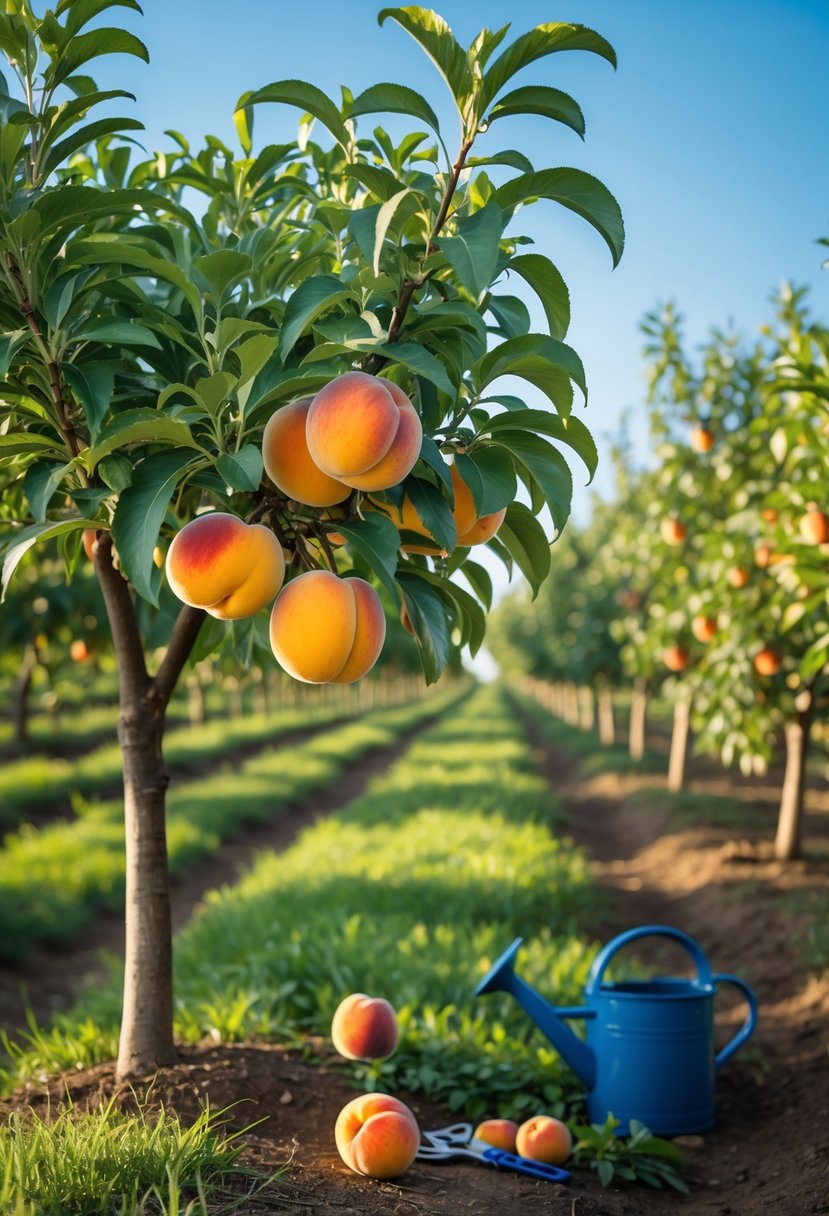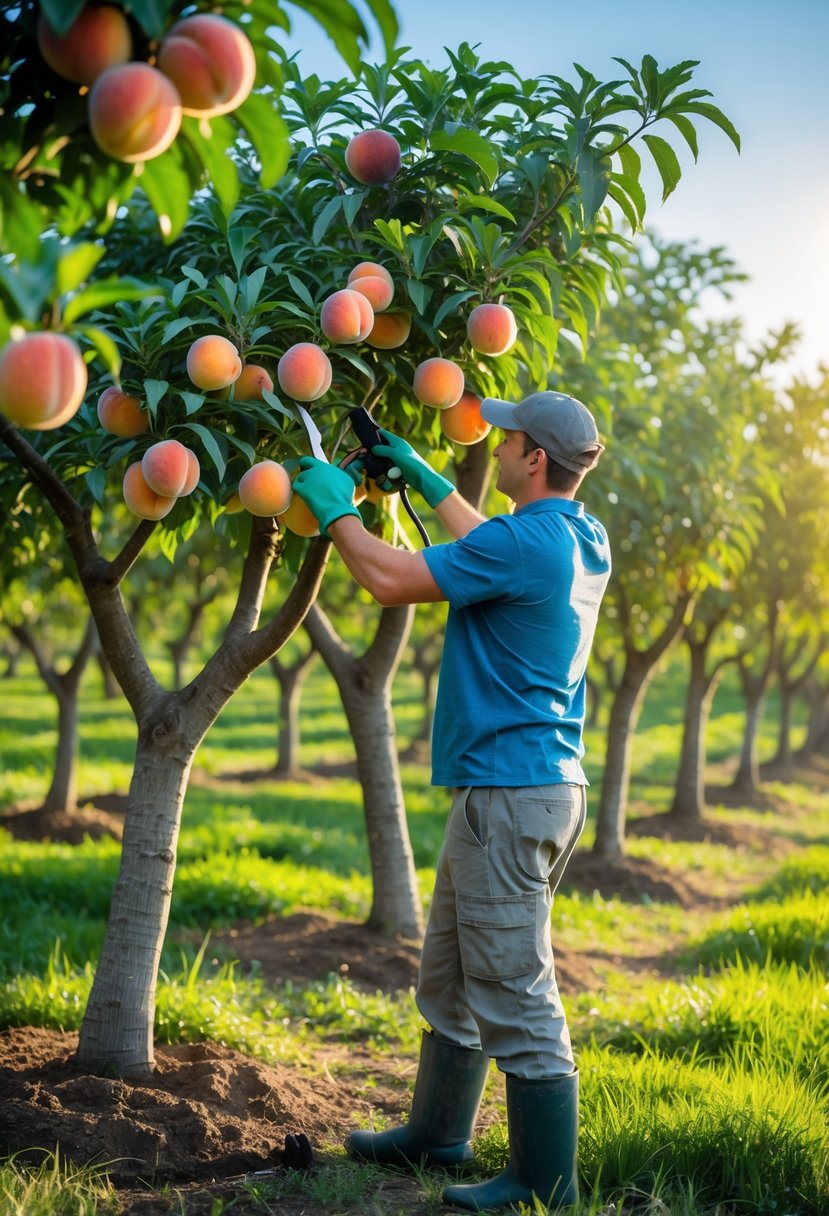How to Grow and Care for Peach Trees: A Complete Guide
Growing peach trees can be a rewarding addition to your garden, providing sweet, juicy fruit for years. To grow and care for peach trees successfully, you need to plant them in full sun, use well-draining soil, and give them regular water and proper pruning. These steps help the tree stay healthy and produce a good harvest.

Peach trees are self-fertile, so you only need one tree to grow fruit. However, it takes patience because it may take three to four years before you see peaches. Paying attention to soil quality, watering, and protecting the tree from pests will keep it healthy and strong.
Knowing how to choose the right spot and care for your peach tree will help you enjoy fresh peaches right from your own yard. With simple but consistent care, your tree can thrive and provide fruit for many seasons.
Key Takeways
- Plant your peach tree in a sunny spot with good soil.
- Water and prune your tree regularly for healthy growth.
- Protect your tree to ensure a steady fruit harvest.
Choosing and Planting Peach Trees

Before planting peach trees, it’s important to pick the right variety, prepare your site properly, and know how to plant for the best results. Each step affects your tree’s health and fruit production.
Selecting the Right Variety
Choose a peach variety that matches your local climate. Different varieties need different chill hours, which is the amount of cold weather required to bloom and produce fruit. If your area is warmer, pick low-chill varieties. For cooler climates, cold-hardy types work better.
Decide if you want to grow from pits, seeds, or nursery trees. Growing from pits or seeds takes longer — often 3 to 4 years before flowering — and the fruit may differ from the parent tree. Nursery trees are usually grafted and fruit sooner with known qualities.
Site and Soil Preparation
Peach trees need at least 6 hours of direct sunlight daily. Choose a spot with well-drained soil to avoid root rot. Avoid low-lying areas where water collects.
Check your soil’s pH. Peach trees grow best in soil with a pH between 6 and 7. Loosen the soil to about 18 inches deep before planting. Mix in organic matter like compost to improve drainage and fertility.
How to Plant Peach Trees
Dig a hole twice as wide and as deep as the tree’s root ball. Set the tree so that the graft union (the bump on the trunk) sits 2 inches above soil level.
Spread out the roots gently and fill the hole with soil, pressing lightly to remove air pockets. Water deeply right after planting.
If you’re growing from pits or seeds, start them indoors to protect from frost. After seedlings grow strong, transplant them outside in spring, making sure to keep soil moist and warm.
Essential Care for Healthy Growth

To keep your peach tree strong and productive, you need to focus on giving it the right water and nutrients, trimming it properly, and protecting it from pests and diseases. Each care step plays a key role in supporting growth and fruit quality.
Watering and Fertilizing
Water your peach tree deeply about once a week. Aim for 1 to 2 inches of water each week, more during hot or dry weather. Use drip irrigation or a soaker hose to deliver water directly to the roots. Avoid keeping the soil soggy to prevent root rot.
Fertilize your tree once a year in early spring before buds open. Use a balanced fertilizer like 10-10-10. Apply the amount recommended for your tree’s age on the package. You can also add compost or magnesium if the leaves show yellowing or poor growth. Test your soil regularly to adjust fertilizer needs accurately.
Pruning Techniques
Prune your tree in late winter or early spring when it is still dormant. Remove dead, damaged, or crossing branches to improve airflow and allow sunlight to reach all parts of the tree. This helps reduce disease and supports healthy fruit development.
Shape the tree with an open center by cutting back branches to keep the middle clear. Remove suckers and water sprouts that will waste the tree’s energy. Regular pruning also helps control the tree’s size and encourages new growth.
Protecting from Pests and Diseases
Watch your tree weekly for signs of pests like aphids or scale insects. Use insecticidal soap or neem oil, applied early in the morning or late in the evening to avoid harming beneficial insects.
Common diseases include peach leaf curl and brown rot. Apply fungicides in early spring and clean fallen leaves or fruit from around the tree. Pruning to increase air circulation also lowers disease risk. Consider planting resistant varieties if pests or diseases are persistent.
Maximizing Peach Harvest and Tree Longevity

To get the most fruit from your peach tree and help it live longer, you must focus on proper harvesting methods, consistent seasonal care, and managing environmental challenges. Paying attention to these details will boost fruit quality and keep your tree healthy for many years.
Harvesting Peaches
Pick peaches when they are soft to the touch and smell sweet. Ripe peaches usually come in late summer. Gently twist each fruit off the branch to avoid bruising.
Handle peaches carefully. Bruises reduce fruit quality and storage life. Store ripe peaches in a cool, dry place or refrigerate them to keep fresh for up to a week.
Pick regularly to avoid overripe or fallen fruit that can attract pests. Removing excess fruit early can also help remaining peaches grow larger.
Seasonal Maintenance
Water your peach tree regularly during dry spells, keeping soil moist but not soggy. Applying 2-3 inches of mulch helps retain soil moisture and control weeds.
Prune your tree every early spring before buds open. Remove dead or crowded branches to improve air flow and sunlight exposure, which reduces disease risk.
Apply a balanced fertilizer each spring. Start with 1 pound of 10-10-10 fertilizer per young tree and increase gradually, up to 10 pounds for mature trees.
Monitor for pests and diseases year-round. Treat peach tree borers and fungal infections quickly to prevent serious damage.
Dealing with Climate and Environmental Stress
Peach trees need 600 hours of temperatures below 45°F to produce fruit properly. If you live in warmer areas, choose low-chill varieties suited for your climate.
Protect your tree from late spring frost by planting on higher ground and covering young buds if cold weather is expected.
Avoid overwatering in humid climates to prevent fungal diseases. Ensure good air circulation by pruning and spacing trees properly.
In cold regions, apply a thick mulch layer in fall and wrap trunks with burlap to protect against freezing temperatures. This reduces winter damage and supports healthy regrowth in spring.





